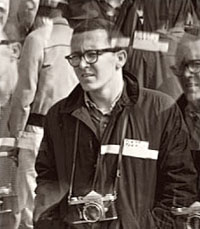Loading AI tools
American journalist From Wikipedia, the free encyclopedia
James "Spider" Martin (April 1, 1939 – April 8, 2003) was an American photographer known for his work documenting the American Civil Rights Movement in 1965, specifically Bloody Sunday and other incidents from the Selma to Montgomery marches.[1][2]
James "Spider" Martin | |
|---|---|
 | |
| Born | April 1, 1939 Fairfield, Alabama, U.S. |
| Died | April 8, 2003 (aged 64) Blount Springs, Alabama, U.S. |
| Nationality | American |
| Occupation | Photographer |
| Known for | Two Minute Warning |
Martin was born in Fairfield, Alabama. He was slightly built at 5 feet 2 inches (1.57 m) tall and 125 pounds (57 kg), and though he would climb trees and church towers to get a different angle for his photographs,[2] his nickname "Spider" dates back to his school days at Hueytown High, where a reporter described him as moving "like a spider" during one of his touchdown runs on the football field.[3]
Whilst working as a photographer for The Birmingham News[4] he was assigned to cover the death of Jimmie Lee Jackson in February 1965;[3] one month later, he created a notable photograph of the civil rights era, entitled Two Minute Warning, during the 1965 Selma Voting Rights Movement.[5] His photograph showed Alabama state troopers about to attack the first peaceful Selma to Montgomery march with batons and tear gas just after it had crossed the Edmund Pettus Bridge from Selma into Dallas County on 7 March 1965.[6] Hosea Williams and John Lewis were leading the planned 54-mile (87 km) march to the Alabama State Capitol in protest at unfair treatment of African Americans and discriminatory voting rights practices.[2] The incident, known as Bloody Sunday, the media coverage of it and the national outcry that ensued, were influential in the course of civil rights in the U.S. Speaking about the effect of photography on the Civil Rights Movement, Martin Luther King Jr. said, "Spider, we could have marched, we could have protested forever, but if it weren't for guys like you, it would have been for nothing. The whole world saw your pictures. That's why the Voting Rights Act was passed."[3][7]
Martin would join the third march, covering it from start to finish, at the Alabama State Capitol building.[1][2] During the march, Martin took a photograph of an exhausted minister from Maine on the verge of quitting the march. Martin told him "I weigh 125 pounds, my camera bag is 50 pounds, and I [am] walking backwards and shooting pictures" and helped the minister back to his feet.[8][9] After the Selma to Montgomery marches, Martin covered the trial of the murderer of Viola Liuzzo and George Wallace's 1968 presidential campaign, reportedly telling the candidate "I won't vote for you, but I'll take your money."[2]
His photographs were published in Life, Saturday Evening Post, Time, Der Spiegel, Stern, Paris Match,[citation needed] Birmingham Weekly[10] and The Birmingham News.[2]
He was represented for several years by Black Star, from 1965.[11]
The Dolph Briscoe Center for American History at the University of Texas at Austin acquired Martin's archive of negatives, correspondence, memos, clippings, and other material in 2015 for $250,000.[2][5][12]
He died by suicide on April 8, 2003[5][13] in Blount Springs, Alabama.[12]
Martin's photographs are held in the following permanent collections:
Seamless Wikipedia browsing. On steroids.
Every time you click a link to Wikipedia, Wiktionary or Wikiquote in your browser's search results, it will show the modern Wikiwand interface.
Wikiwand extension is a five stars, simple, with minimum permission required to keep your browsing private, safe and transparent.